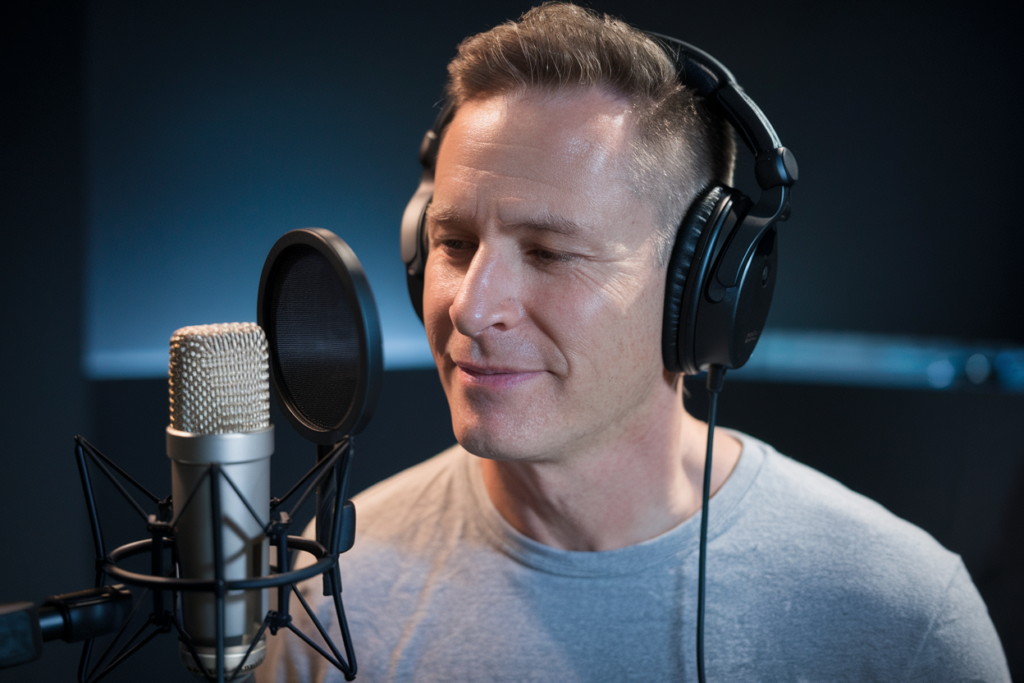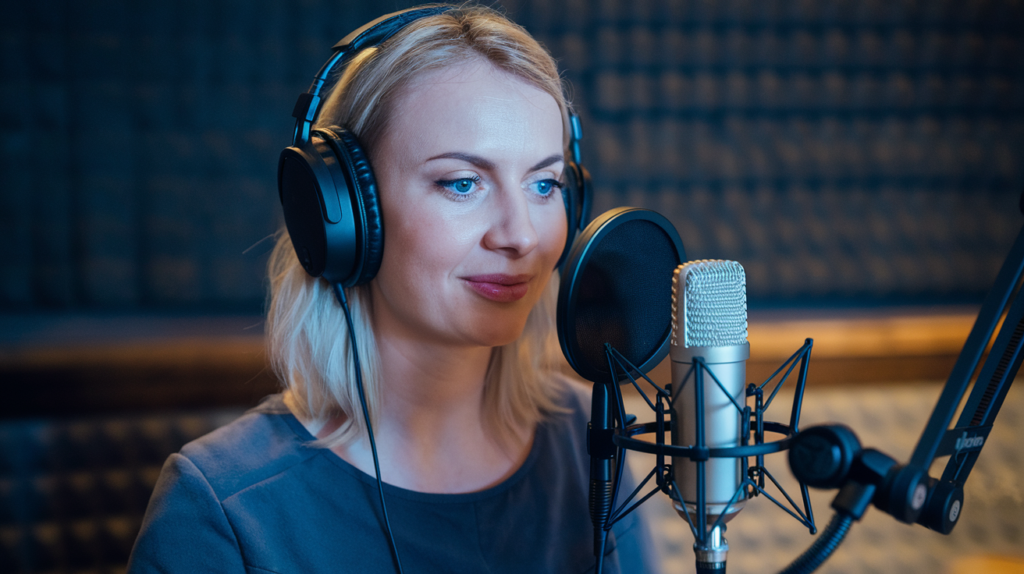Key Takeaways
- Understanding Language Nuances: Mastering the intricate pronunciation rules of Polish, such as sounds like «ń» and «ł,» is crucial for delivering authentic voiceovers.
- Cultural Context Matters: Familiarity with Polish idioms, humor, and cultural references enhances emotional connection with local audiences.
- Technical Equipment Needs: Investing in quality microphones, audio interfaces, and soundproofing materials is essential to achieve high-quality recordings.
- Address Sound Quality Issues: Avoid background noise and distortion by maintaining proper recording levels and mastering tracks effectively for consistency across playback systems.
- Preparation is Key: Practicing pronunciation, understanding cultural context, and analyzing your script beforehand can significantly improve recording outcomes.
- Collaborate with Native Speakers: Seeking feedback from native Polish speakers helps refine delivery and ensures a more relatable final product.
Have you ever tried recording Polish voiceovers and hit a wall? You’re not alone. Many voice artists face unique challenges when it comes to capturing the nuances of the Polish language, from tricky pronunciations to cultural context that can make or break your project.
Understanding these difficulties is crucial if you want to deliver high-quality recordings that resonate with your audience. Whether you’re a seasoned pro or just starting out, navigating the intricacies of Polish voiceovers requires insight and strategy. Let’s dive into some common obstacles you might encounter and explore effective solutions to elevate your work.
Understanding Polish Voiceovers
Polish voiceovers present unique challenges that require a keen understanding of the language and culture. You’ll find that grasping these nuances is essential for creating impactful recordings.
Importance of Polish Voiceovers
Polish voiceovers play a crucial role in connecting with audiences. They help convey messages effectively, ensuring your content resonates with Polish speakers. Whether it’s for advertising, e-learning, or entertainment, using an authentic voice can enhance engagement. A skilled voice artist can capture emotions and tone, making your project more relatable to the target audience.
Common Uses of Polish Voiceovers
You’ll encounter various applications for Polish voiceovers across industries:
- Advertising: Companies use engaging voice talent to promote products and services.
- E-learning: Educational platforms benefit from clear instruction delivered by experienced voice actors.
- Audiobooks: Narration by proficient voice over artists brings stories to life.
- Film and Animation: Characters become more believable with authentic local accents provided by talented voiceover professionals.
- Corporate Videos: Businesses often employ professional voices to deliver presentations or training materials effectively.
Understanding these common uses helps you recognize the value of quality Polish voiceovers in enhancing your projects’ overall effectiveness.
Challenges in Recording Polish Voiceovers
Recording Polish voiceovers presents unique challenges that can affect the quality and impact of your project. Understanding these difficulties helps you navigate the recording process more effectively.
Language Nuances
Polish is a phonetic language with intricate pronunciation rules. Certain sounds might not exist in other languages, making them tricky for voice artists to produce correctly. For instance, the Polish «ń» and «ł» can pose challenges even for experienced voice actors. Mispronouncing these can lead to misunderstandings or diminished authenticity in your recordings. Attention to detail during rehearsals ensures clarity and proper intonation, ultimately enhancing audience engagement.
Cultural References
Cultural context plays a crucial role in delivering relatable content through voiceovers. Polish culture includes specific idioms, humor, and references that resonate with local audiences but may confuse non-native speakers. Voice talents must grasp these cultural nuances to connect emotionally with listeners. Incorporating familiar phrases or culturally relevant anecdotes enriches the narrative while fostering trust between the brand and its audience.
By acknowledging these challenges—language nuances and cultural references—you position yourself as a knowledgeable client ready to collaborate effectively on high-quality Polish voiceover projects.
Technical Difficulties
Recording Polish voiceovers presents unique technical challenges that can impact the final output. Understanding these difficulties is essential for achieving high-quality results.
Equipment Requirements
You need specific equipment to ensure clarity and professionalism in your recordings. A quality microphone, such as a condenser or dynamic mic, captures the nuances of your voice effectively. An audio interface improves sound quality by converting analog signals to digital formats. Additionally, soundproofing materials like foam panels help eliminate background noise and echo, creating a more polished recording environment. Investing in reliable software for editing and mixing also plays a vital role in enhancing the final product.
Sound Quality Issues
Sound quality issues frequently arise during Polish voiceover sessions. Background noise can disrupt recordings, making it hard for listeners to focus on your message. Distortion often occurs if levels are set too high during recording; keeping levels within recommended ranges prevents this problem. Moreover, mastering tracks properly ensures consistency in volume across different playback systems, which is crucial for maintaining audience engagement. Avoiding these pitfalls helps create clear and impactful voiceovers that resonate with listeners.
By addressing these technical difficulties head-on, you enhance the overall effectiveness of your Polish voiceovers and connect better with your audience.
Tips for Overcoming Difficulties
Navigating the complexities of recording Polish voiceovers can be challenging. Here are some effective strategies to enhance your recordings and connect with your audience.
Preparing for the Recording Session
- Practice Pronunciation: Familiarize yourself with tricky sounds like «ń» and «ł.» Use online resources or pronunciation guides to hear how native speakers articulate these phonemes.
- Understand Cultural Context: Research cultural references, idioms, and humor that resonate with Polish audiences. This knowledge can help you deliver lines more authentically.
- Create a Script Breakdown: Analyze your script before recording. Identify sections that may require special attention due to complex phrases or challenging pronunciations.
- Set Up Your Space: Ensure your recording environment is soundproofed and free from distractions. Background noise can disrupt clarity, so consider using acoustic panels or blankets.
- Test Equipment: Check all audio equipment ahead of time, including microphones and audio interfaces. A quick test run helps identify any technical issues early.
Collaborating with Native Speakers
- Seek Feedback: Work closely with native Polish speakers who understand nuances in language and culture. Their insights can significantly improve your delivery.
- Join Online Communities: Participate in forums or social media groups focused on Polish voiceovers where you can exchange tips and experiences with fellow voice artists.
- Engage in Practice Sessions: Schedule practice sessions with native speakers to refine your pronunciation skills before actual recordings.
- Share Your Recordings: Send samples of your work to native speakers for critique; their feedback will help you identify areas for improvement.
- Embrace Collaborative Tools: Utilize platforms designed for remote collaboration, allowing you to share scripts and recordings seamlessly while gathering input from others.
By implementing these tips, you’ll navigate the unique difficulties of Polish voiceovers more effectively, enhancing both the quality of your work and engagement with audiences across various applications like advertising, e-learning, audiobooks, film animations, and corporate videos.
Conclusion
Recording Polish voiceovers presents unique challenges that can significantly impact the quality of your work. By understanding these difficulties and implementing effective strategies, you can enhance your recordings and create a deeper connection with your audience.
It’s essential to focus on pronunciation nuances and cultural context while ensuring high technical standards during recording sessions. Embracing collaboration with native speakers and leveraging online resources will further elevate your skills.
As you navigate these complexities, remember that overcoming these obstacles not only improves your craft but also enriches the experience for Polish-speaking listeners. With dedication and practice, you’ll find yourself producing impactful voiceovers that resonate in various applications from advertising to education.
Frequently Asked Questions
What are the main challenges of recording Polish voiceovers?
Recording Polish voiceovers presents challenges such as tricky pronunciations, intricate phonetic rules, and the need for cultural understanding. Specific sounds like «ń» and «ł» can be difficult to pronounce correctly, which may lead to misinterpretations. Additionally, grasping idioms and references familiar to Polish audiences is crucial for authentic recordings.
Why is cultural context important in Polish voiceovers?
Cultural context enriches the connection between the voice artist and the audience. Understanding local idioms, humor, and societal references ensures that the message resonates effectively with Polish speakers. This familiarity enhances relatability and engagement in various applications like advertising or e-learning.
How can I improve my pronunciation when recording Polish voiceovers?
To enhance your pronunciation, practice challenging sounds regularly and consider breaking down scripts into manageable portions. Listening to native speakers can also help you identify correct pronunciations. Recording yourself can provide valuable feedback for improvement.
What equipment do I need for high-quality Polish voiceover recordings?
Essential equipment includes a quality microphone, an audio interface for clear sound transfer, headphones for monitoring audio quality, and soundproofing materials to minimize background noise. Investing in these tools will significantly enhance your recording’s clarity and professionalism.
How can collaboration benefit my Polish voiceover projects?
Collaborating with native speakers offers insights into cultural nuances and accurate pronunciations that may not be readily apparent to non-natives. Feedback from experienced individuals helps refine your work while joining online communities fosters shared learning experiences among peers.
What practical tips can help me prepare for a recording session?
Prepare by practicing tricky pronunciations ahead of time and create a script breakdown highlighting challenging sections. Set up a quiet recording space with proper equipment testing before starting sessions. Engaging in mock recordings can also boost confidence during actual takes.







